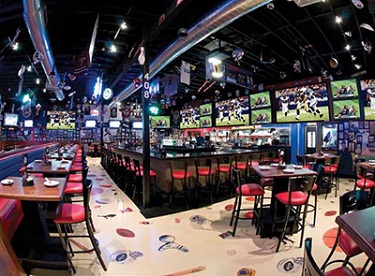- Ask yourself this: Are you guilty of taking your projection screen choices for granted? Of failing to execute the exacting calculations that could mean the difference between one selection and another?
Vutec’s ambient light rejecting SilverStar screen performs well in bars, restaurants, and environments with challenging lighting conditions.
What’s that, you’re stuck in a market niche? Perhaps it’s time to explore opportunities outside your comfort zone, even if that zone seems to be dictated by your core customer base. There are many more opportunities in the commercial market beyond classrooms and boardrooms.
But before you sell a product, ensure that you are considering the particulars such as configuration tools, screen surface options, and shapes and sizes. For example, if you’re not factoring in room lighting to calculate systems contrast, you may only be guessing at the outcome of image quality.
“In a room with high ambient light, you can have two screens with different surfaces look very different with the same projector,” explained Steve Cook, national AV consultant manager for Draper. “They can both be bright enough, but you can make the image pop with a high-performance screen material by trying to steer the ambient light away and help correct the black levels.”
A good online screen material calculator can help a designer figure out an appropriate image brightness level and system contrast ratio if they have all the necessary information, including lighting info, he said. “A screen manufacturer needs to have a good selection of materials to accommodate many different end-user applications, and to handle the conditions in those applications. A good online calculator will help show how each material will perform in those conditions and will help to make a recommendation.”
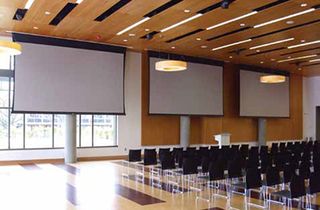
Da-Lite’s Dual Vision and Ultra Wide Angle rear-projection surfaces have been reformulated for rear-projection blending and special applications.The designer will still need to factor in other pieces of information the calculator cannot compute, and that would only be known by the designer, such as seating configuration. “The manufacturer also needs to accommodate the different custom shapes for projects like museums, where a certain concept is trying to be achieved, as well as the various aspect ratios of source content from PCs to film and the native resolutions of the projectors,” Cook added.
To address the reformatting of screen surface options, along with custom requests, Da-Lite has developed a new line of HD Progressive front-projection surfaces for high-definition projection and frontprojection edge-blending applications.
“We have also re-formulated our Dual Vision and Ultra Wide Angle rear projection surfaces for rear projection blending and special applications,” said Da-Lite marketing coordinator Brian Schwartz. “We are seeing more and more requests for large-format electric screens and fixed frame screens, both flat and curved. Those for large-format screens requiring blended images, and also for special shapes and sizes on fixed frame screens, are a growing segment that we are excited about.”
In terms of screen surfaces, Vutec Corporation’s ambient light rejection patented SilverStar screen has performed well in the market, said Michael Palmisano, director of marketing and communications. “Integrators have favored high-gain materials for bars, restaurants, and environments with lighting conditions.”
Stewart Filmscreen’s trajectory has evolved from a focus on material formulation to an integrated approach involving advancements in material science as well as development of highly sophisticated framing and deployment options, said Grant Stewart, president/ CEO.
“In doing so, we have truly expanded the market for custom projection solutions. More recently, we have added a third pillar to our focus which is on educating and enabling our customers to have access to the world of possibilities for their commercial AV project. Web SA is an example of a tool we have developed to guide our customers through the myriad of variables and options that go into choosing the right screen for a given application. By empowering our clients to deliver mind-blowing AV experiences for their clients, we are also inspiring them to dream up even more advanced solutions for new projects. In this sense, we are creating partnerships in innovation with our dealers.”
Staying the Course
Elite Screens has made it a priority to maintain an intimate sense of communication with dealers to assess the trends.
“That has been a huge factor for us in terms of our production channel,” said David Rodgers, Elite marketing manager. “We focus on having products on hand, available immediately to address issues of time sensitivity in commercial applications where lead times for custom-built screens are too long. The quality matches that of what customers can get elsewhere, but we focus on most of the commonly requested sizes. And if something catastrophic happens to a screen, we always have a replacement.”
The economic crash of 2008 sealed the fate of high-dollar installations being an everyday occurrence, he said. “The new market trend was for the same high quality but at a lower cost while the small amount of top-tier installations went to only a fortunate few. The solution is in dedicated lines with custom features such as enhanced materials and extra electronic features that are unavailable on retail screens and fill a gap in the integrator market. These include the Lunette A4K curved frame projection screen with next-generation acoustically transparent material and the Airbright5D with enhanced contrast high-end layering.”
To fill the gap between low-end projectors for smaller jobs with 4,000 lumens up to 10,000 lumens projectors, Elite formed a U.S. subsidiary, AirFlex5D. “We came up with a stacking processor that can be daisy-chained to combine output into one focused image,” Rodgers said.
Where the Opps Are
When the economy takes a hit, education and HO W markets tend to do well. On a cautionary note, although public schools are a guaranteed market, private schools may suffer in a bad economy.
“When the market is down, it’s a good time to build your business and to hire workers, often at lower wages,” Rodgers said. “And casinos are what I call ‘money farms.’ A bad economy to them is like a bad crop; they are built on long-term plans to accumulate wealth across many seasons of bull and bear markets. For this reason, they are also a strong market because in a downturn they can downsize their floor space and staffing but not their AV systems.”
Don’t overlook other opportunities such as those in performing arts auditoriums, government facilities, and medical/pharmaceutical entities.
“There is some 3D aside from public theaters still happening out there, not a lot due to lack of content, but some in museums where content is created specifically for the venue,” Cook said. “The energy market is strong with new locations going up and adding various types of rooms including 3D and visualization rooms.”
And don’t overlook the upgrade prospects for classrooms and offices to widescreen formats, either 16:9 or 16:10. “As these facilities upgrade their systems to highdefinition computer/video sources and projectors, we see an opportunity to upgrade the projection screen to the new format and our newer HD Progressive surfaces to accommodate the higher definition now and for future upgrades beyond 1080p,” Schwartz said.
The simulation market also is strong right now, powered by advancements in technology that make virtual reality much more real. “Economic factors have contributed to the demand for simulation products, as the cost and convenience of simulators vs. real-world training presents a very strong motivation for training managers to pursue these solutions,” Stewart said. “Effective simulation applications rely on creating an immersive viewing experience for the trainee.”
To deliver this, the projected image must fill the viewer’s visual field and the fidelity and uniformity of the image must be perfect, he said. “Stewart Filmscreen materials are known to be the most uniform in the industry. Through our unique, technologically advanced production methods, we are able to control the application of materials at a microscopic level, ensuring the intended effect of projecting light upon the screen and enabling perfect image fidelity. We also have framing technologies that allow the screen to curve around the viewer. At I/ITSEC in Orlando, FL, we are showing a 240-degree self-laminated, semi-rigid, and curved, rearprojection screen running a three-channel, edge-blended simulation application.”
As digital signage continues to evolve, so do higher resolution displays and projectors. “There is huge growth in the video wall segment of the market being driven by flat panels and video tile product,” Stewart said. “These products have numerous advantages and are becoming easier to deploy. However, the limitation of using multiple panels or tiles to render a large image is that you will have horizontal and vertical seam lines running through the image. As this market continues to grow and mature, there will more demand for large, seamless images to create a truly immersive viewing experience.”
Although 3D has been all the talk for the last couple of years, 4K (UH D) is getting equal traction. “Manufacturers are jumping on to compete, creating a great market for the customer who has the confidence to move forward,” Rodgers said. “The good news is that the drop in prices instills buyers with a higher level of confidence.”
Karen Mitchell is a freelance writer living in Boulder, CO.
Stewart Mystik!
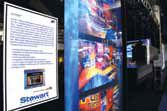
Mystik! is a self-adhesive projection film designed for transforming existing windows and storefronts into high performance digital signage solutions. Mystik! is specially formulated with contrast-enhancing properties, offers excellent off-axis viewing, and is 4k+ ready, meaning it is suitable for enhanced resolution projectors and content. Custom sizes and aspect ratios are available upon request. Mystik! is also available in roll form up to 78-inches wide and 50-feet long for trimming on-site.
Draper High Performance XS850E
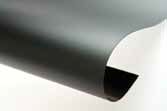
Draper’s High Performance XS850E offers superior ambient light rejection capability, precise resolution, high contrast, a vivid color palette, and a .85 gain. High Performance XS850E gives a bright image in the dark or with ambient light. What sets it apart is the 180 degree viewing cone. You see the same great image off axis, and the contrast levels are excellent in all conditions. High Performance XS850E is available on Draper’s Clarion and Onyx fixed screens.
Elite Insta-DE2

The Insta-DE2 is a wall covering material that converts entire walls into a professional dry-erase whiteboard/ projection screen surface. It is appropriate for use with standard or short throw projectors. The Insta- DE2 is made with Elite’s Greenguard certified Versawhite whiteboard-projection screen material coated with a long-lasting and scratch-resistant optical nanotech layer for daily dry erase white board usage. Larger sizes include 4.2-feet by 10- to 30-feet large training room sizes.
dnp Supernova Blade
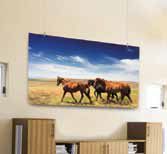
dnp Denmark recently launched the dnp Supernova Blade, available with Supernova 08-85 ISF certified film, and the new Supernova HG highgain material. The Blade features a frameless design that gives the illusion that the screen is floating in mid-air. The Supernova Blade is available in 100-inch, 110-inch, and 120-inch sizes. The film is laminated on aluminum panels and includes all cabling and hardware. A wall mount version is also available.
Vutec Lectric II

The Lectric II is an extruded aluminum ceiling flushmount motorized screen, suitable for air handling spaces, and designed for use with all self-supported screen surfaces. This design accommodates additional leader lengths, includes a built in ceiling trim kit, and a screen mounting internal sliding bracket system. Lectric II also includes a pre-construction option that allows the housing to be installed independently prior to the fabric and motor assembly. This provides for safety and ease of installation for new construction or renovation applications. Vutec specializes in providing custom products, and the Lectric II can be completely customized for any commercial application.
Da-Lite Tensioned Conference Electrol
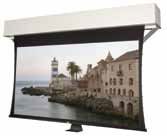
The Tensioned Conference Electrol from Da-Lite is an electric screen that allows the projection screen and video conferencing camera to be completely concealed when not in use. The housing of the Tensioned Conference Electrol is designed to be recessed in the ceiling and includes a trim flange for a clean, finished installation. The shelf for the video conferencing camera lowers via arms behind the screen surface. When retracted, the screen surface and video conferencing shelf arms are concealed by closure doors, allowing the room aesthetics to remain undisturbed. The Tensioned Conference Electrol is available in sizes up to 10-feet wide with any of Da-Lite’s flexible front projection surfaces.
Projecting Ahead
You don’t need a crystal ball to tell you that the 2013 projection screen market will demonstrate once and for all that it has evolved into something vastly different from what it was previous to the downturn of 2008.
Cost-effective product is now a much more important factor, and customers are increasingly vocal about wanting bigger bang for the buck coupled with quality.
The plummeting projector cost has directly influenced costs in the integrator market, Elite Screens’ David Rodgers said. “Some projectors costing from $500 to $2,500 in the retail market now perform as well as the commercial-grade projectors of seven years ago that cost $50,000 and up. And we’ll see a lot more accessibility in short-throw projectors and anamorphic technologies.”
Since screen cost is proportional to that of the projector, 2013 promises to give us exponentially lowered screen prices. Customers will also want more specialty features such as polarized 3D materials to work with 2D presentations as well as acoustically transparent screen materials.
Some who went the flat panel route, often because of a bad experience with projection design, are coming back home. “This is after they realized that what they purchased with their budget is not large enough for presentation use,” Draper’s Steve Cook said. “They may also find that a flat panel is fine for a bright room when doing videoconferencing, but for a presentation they might want to have a screen come down from the ceiling in front of the flat panel.”
Cook predicts that some passive 3D color combining systems, such as Dolby’s 3D system, may see more traction and use since they don’t require a silver screen, which has been a limiting factor in traditional stereoscopic polarizing 3D systems. “The cost of the glasses for these systems is very reasonable,” he added.
Opportunities in the corporate, higher education, and government markets are expected to strengthen in a post-election uptick. “We have already experienced growth in these sectors with an increasing demand and a concentration of boardroom installations, digital signage projects, and in rental and staging,” VuTec’s Michael Palmisano said. “For the rental and staging market, we recently developed the Retracta Vu Traveller Projector Lift and the Retracta Vu Traveller Screen, both of which are plug-n-play patented products.”
With companies curtailing traveling costs in favor of videoconferencing solutions, more top-level corporate clients are expected to invest in high-end conference and boardrooms, both in technology and in design finishes.
“The technological costs can include microphone/audio conferencing systems, bandwidth for HD videoconferencing, projection screen, and, usually, rear-projection displays complimented with complete wireless touch panels,” Stewart’s Grant Stewart said.
To save on setup costs, he said, the company offers clients its Video Conferencing Screen (VCS), a standard electric screen, outfitted with customized camera mount that hold the camera. “Often times, the camera is glaringly visible in many videoconferencing setups, which in addition to looking unattractive, makes people more self-aware and uncomfortable, which ultimately can lead to decreased productivity and limits participation. Our VCS can be optimized with any of Stewart’s award-winning front projection materials. Microperf X² is also available when acoustic transparency is required.”
No matter how you do the math, it all comes back to customer demand and market share. “The specialized custom niche is so small,” Rodgers said. “I see other big manufacturers trying to come into our channel in 2013 with new lines straddling that integrator/retailer niche. Our answer is that we will not change our model of keeping the ready-to-go products. Availability is a huge selling factor for us.”
—K.M.
